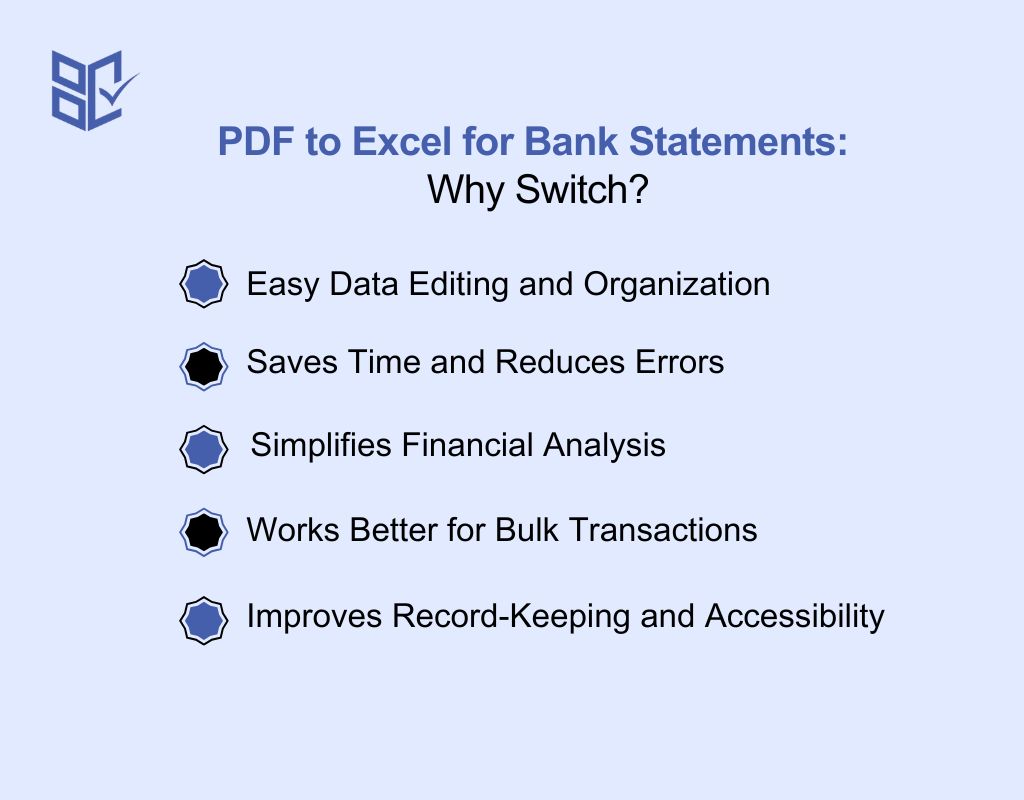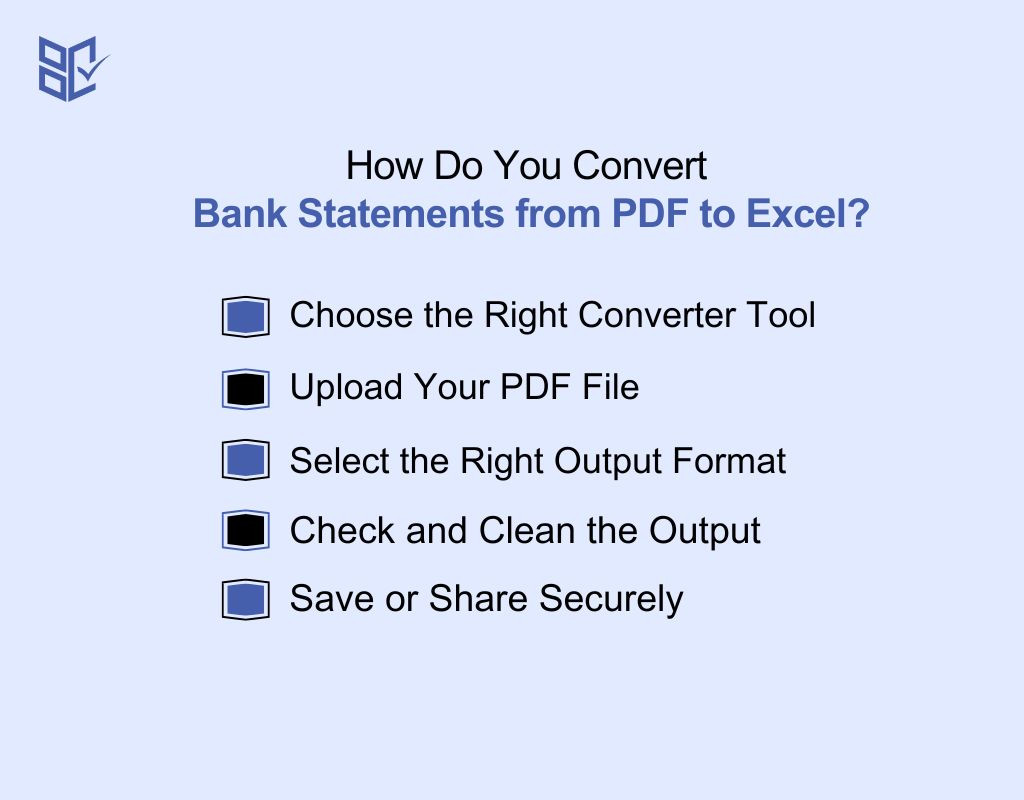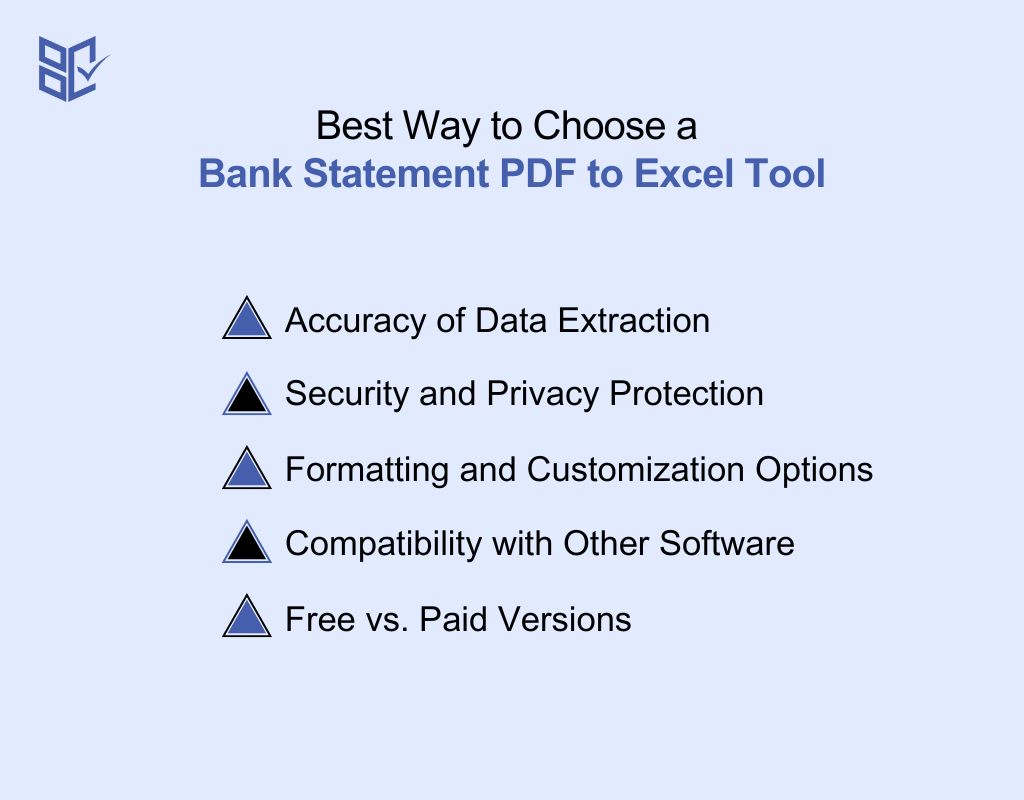PDF to Excel Bank Statement Converter
Easily convert PDF bank statements to Excel for accurate transaction tracking and financial analysis. Use a reliable PDF to Excel bank statement converter now.
Add Your File
Drag & Drop Or Select File
Data security is our top priority
Bank Statement Converters prioritises the confidentiality and integrity of your data. As a testament to our commitment, we adhere to stringent compliance standards, including GDPR, SOC 2, and HIPAA. Privacy Policy



How to Convert Your PDF to Excel Bank Statement
Why Choose PDF to Excel Bank Statement Converter?
Accessibility
Bank Statement Converter offers easy access—convert bank account transactions or statements into Excel spreadsheets quickly without OCR tools or technical skills.
Affordable Plans for Everyone
Affordable Plans for Everyone tailored to meet diverse needs without breaking the bank, offering flexibility and value for all.
Starter
$90 / month
Save 10% annually
Why should you take this
4,800 pages per year
PDF Bank Statement to Excel
PDF Bank Statement to CSV
Convert Password Protected Statement
Multiple PDFs to a Single CSV
Global Banks Supported
Get Started
Professional
$180 / month
Save 20% annually
Why should you take this
12,000 pages per year
PDF Bank Statement to Excel
PDF Bank Statement to CSV
Convert Password Protected Statement
Multiple PDFs to a Single CSV
Global Banks Supported
Get Started
Business
$360 / month
Save 20% annually
Why should you take this
48,000 pages per year
PDF Bank Statement to Excel
PDF Bank Statement to CSV
Convert Password Protected Statement
Multiple PDFs to a Single CSV
Global Banks Supported
Get Started
Most Popular
Enterprise
$Custom / month
Save 20% annually
Why should you take this
PDF Bank Statement to Excel
PDF Bank Statement to CSV
Convert Password-Protected Statement
Multiple PDFs to a Single CSV
Global Banks Supported
Get Started
PDF to Excel Bank Statement Converters vs. Traditional Methods: What Works Best?
Features
PDF to Excel Bank Statement Converter
Traditional Methods
Auto table detection
OCR for scanned PDFs
Preserves row/column structure
Supports batch conversion
Editable Excel output
Minimal manual effort
Error handling tools
Real time conversion speed
Built in formatting control
Secure data processing
Frequently Asked Questions
Are online PDF to Excel converters safe to use for bank statements?
Can I batch convert multiple bank statements at once?
What file formats can I convert my bank statement into besides Excel?
Handling your finances should be easy, but PDF bank statements often make it hard. They're fine for viewing, but editing or analyzing the data is time-consuming and tricky.
That’s where a PDF to Excel bank statement converter comes in—turning rigid PDFs into flexible, easy-to-use spreadsheets.
Manually copying numbers is time-consuming, and mistakes can cost you. Whether you’re managing business finances, filing taxes, or tracking expenses, converting bank statements to Excel makes life easier.
In this guide, you'll discover why this conversion matters, common challenges, and the best way to do it efficiently.
What Is a PDF to Excel Bank Statement Converter?
A PDF to Excel bank statement converter is a tool that extracts financial data from PDF bank statements and converts it into an editable Excel format. It helps you organize transactions, remove manual data entry errors, and simplify financial analysis for budgeting, accounting, or business reporting.
PDF to Excel bank statement converters extract financial data from PDFs, transfer it into Excel spreadsheet, eliminate manual entry, and simplify transaction management efficiently.
Since PDFs are not easily editable, this tool makes it possible to work with your bank transactions in a structured spreadsheet format. You can sort, filter, and analyze data effortlessly.
Whether you're tracking expenses, preparing financial reports, or reconciling accounts, this conversion saves time and reduces errors. Instead of manually copying numbers—which can be slow and inaccurate—you get a clean, organized Excel sheet that allows you to manage your finances more efficiently.
PDF to Excel for Bank Statements: Why Switch?

If your bank statements are in PDF format, working with them can be frustrating. Converting them to Excel makes financial tasks easier, saves time, and helps you manage transactions more efficiently. Here’s why you should convert PDF to Excel:
Easy Data Editing and Organization
PDFs are not designed for data editing, making it hard to modify or organize transactions. Converting them to Excel allows you to sort, filter, and categorize transactions effortlessly. You can also format the data as needed, making it easier to analyze and use for financial planning or reporting.
Saves Time and Reduces Errors
Manually copying data from PDFs to Excel is time-consuming and prone to mistakes. A converter automates this process, ensuring accuracy and eliminating the risk of human errors. This is especially useful for accountants, business owners, and individuals who need precise financial records without spending hours on manual entry.
Simplifies Financial Analysis
Excel offers powerful tools for financial analysis, such as formulas, pivot tables, and charts. By converting your bank statements, you can easily track expenses, identify spending patterns, and generate reports. This helps in budgeting, tax preparation, and making informed financial decisions without struggling with static PDF files.
Works Better for Bulk Transactions
If you deal with multiple bank statements or large volumes of transactions, handling them in PDF format is inefficient. Converting them to Excel lets you process, analyze, and retrieve information quickly. This is especially helpful for finance professionals managing high transaction volumes across multiple accounts.
Improves Record-Keeping and Accessibility
Excel files are easier to store, search, and share compared to PDFs. You can back up, edit, or merge statements from different periods into a single file. This improves financial record-keeping and ensures that you always have access to well-organized data whenever you need it.
How Do You Convert Bank Statements from PDF to Excel?

Converting your bank statement from PDF to Excel makes it easier to sort, filter, and analyze data. Here’s how to convert bank statement PDF to Excel:
Choose the Right Converter Tool
Look for a PDF to Excel converter made for bank statements. It should handle tables, detect rows, and extract data accurately. Avoid generic converters. They often miss important columns like balances or dates. A good tool saves time and reduces manual corrections. Choose based on reviews, features, and privacy policies.
Upload Your PDF File
Most tools have a drag-and-drop option or upload button. Select your file from your computer or cloud storage. Make sure the file is not password-protected. If it is, remove the protection before uploading. Clean file input helps the converter work smoothly and reduces errors during data extraction.
Select the Right Output Format
Some tools give many export options. You should always select Excel or spreadsheet format. This lets you easily filter, sort, and analyze your bank data. Avoid CSV if your statement has complex formatting. Excel retains rows, columns, and data structure better, giving you cleaner and more useful output.
Check and Clean the Output
Once the file is ready, open it and check every section. Make sure all rows match, dates are in order, and values are in the right cells. Fix merged cells or empty fields. Don’t assume it's perfect. A quick cleanup ensures your data is ready for reporting or analysis.
Save or Share Securely
Once your Excel sheet looks correct, save it in a secure folder. If you need to send it, use encrypted file sharing tools. Bank data is sensitive. Never upload it to untrusted websites. Always delete temporary files created during conversion. This step keeps your financial information private and safe.
Who Should Convert Their Bank Statements from PDF to Excel?
.jpg)
A PDF to Excel bank statement converter is useful for anyone who regularly works with financial data. Whether for business, accounting, or personal finance, converting bank statements PDF to Excel simplifies data management. Here are the key people who benefit from it:
Business Owners and Entrepreneurs
Managing finances is important for any business. A bank statement converter helps business owners track expenses, reconcile accounts, and prepare financial reports efficiently. Instead of manually entering data, they get structured transaction records in Excel, saving time and reducing errors.
Accountants and Financial Analysts
Accountants deal with large volumes of financial data. Converting bank statements to Excel allows them to categorize transactions, analyze spending patterns, and create reports effortlessly. It also ensures accuracy when reconciling accounts or preparing tax documents for clients.
Freelancers and Self-Employed Professionals
Freelancers and self-employed individuals need to track income, expenses, and tax deductions. Since most banks provide statements in PDFs, converting them to Excel helps in budgeting, tax filing, and keeping clear financial records for smooth business operations.
Tax Preparers and Auditors
Tax professionals and auditors require detailed transaction records to ensure compliance and accuracy. Converting PDF statements to Excel makes it easier to verify financial records, detect discrepancies, and generate tax reports without dealing with static, uneditable PDFs.
Corporate Finance Teams
Companies handling multiple bank accounts or high transaction volumes benefit from automated PDF to Excel conversion. It speeds up financial reconciliation, expense tracking, and reporting, allowing finance teams to focus on strategic decision-making instead of manual data entry.
Errors You Might Face Converting PDF Bank Statements to Excel
Converting PDF bank statements to Excel isn’t always smooth. You might face issues like incorrect formatting or missing data. Here’s a table with common problems, their causes, and how to fix them:
Issue | Cause | Solution |
Data Misalignment After Conversion | PDF formatting doesn’t match Excel’s table structure. | Use a converter with table recognition or manually adjust column alignment in Excel. |
Numbers Appear as Text | Excel interprets numbers as text due to incorrect formatting. | Use 'Text to Columns' or change the cell format to 'Number' in Excel. |
Missing Transaction Data | PDF has embedded images or scanned data, making extraction difficult. | Use OCR-based converters or manually input missing data. |
Extra Blank Rows and Columns | PDF contains unnecessary formatting elements that transfer to Excel. | Delete blank rows and columns manually or use Excel’s 'Find & Select' feature. |
Merged or Combined Data in One Column | PDF conversion merges multiple data points into a single column. | Use 'Text to Columns' in Excel to split data into proper fields. |
Loss of Table Structure | Complex table structures in PDF don't transfer correctly to Excel. | Try different converters or reformat the data manually in Excel. |
Best Way to Choose a Bank Statement PDF to Excel Tool

With so many PDF to Excel bank statement converters, choosing the right one can be tricky. To help you decide, here are the key factors to consider for accuracy, security, and ease of use:
Accuracy of Data Extraction
The best converter should extract data accurately without errors. Some tools struggle with formatting, causing misaligned columns or missing transactions. Look for a converter that maintains the original table structure and correctly transfers all financial data without requiring too many manual adjustments.
Security and Privacy Protection
Bank statements contain sensitive information, so security is crucial. Choose a tool that offers encryption, local processing, or secure cloud storage to keep your data safe. Avoid online converters that do not guarantee data protection, especially for confidential financial documents.
Formatting and Customization Options
Some converters allow you to customize how data appears in Excel, such as selecting column structures, merging or splitting data, and adjusting currency formatting. If you work with financial reports, having these options can save time and improve data organization.
Compatibility with Other Software
If you use accounting or financial management software, choose a converter that integrates with tools like QuickBooks, Xero, or Microsoft Excel. This makes data transfer seamless and reduces the need for extra formatting.
Free vs. Paid Versions
Many converters offer free versions, but they may have limitations like file size restrictions, watermarks, or lower accuracy. If you frequently convert bank statements, investing in a premium converter with advanced features and better support might be a smarter choice.
How Does a Bank Statement PDF to Excel Tool Function?

A bank statement converter extracts financial data from PDFs and converts it into an editable Excel format. It automates data processing, making it easier to organize, analyze, and manage transactions without manual effort. Here’s how bank statement converters work:
Uploading the PDF File
The process begins by uploading your bank statement PDF into the converter. Some tools allow direct drag-and-drop, while others require file selection. A good converter supports multiple file formats, ensuring compatibility with different types of bank statements.
Recognizing and Extracting Data
The tool scans the PDF to detect text, tables, and numbers. Advanced converters use Optical Character Recognition (OCR) for scanned statements and intelligent algorithms to extract structured transaction data while preserving formatting accuracy.
Identifying Key Transaction Details
The converter separates important details like date, description, amount, balance, and category from the statement. It ensures that each transaction is placed in the correct column, avoiding misplaced or merged data in the Excel file.
Formatting and Structuring the Data
Once extracted, the tool organizes data into an Excel-friendly format. It removes unnecessary elements like headers, footers, or page numbers. Some converters also allow you to customize column layout, apply formulas, or set currency formats for better readability.
Converting and Downloading the Excel File
After processing, the converter generates an Excel file that you can download. This file is fully editable, allowing you to filter transactions, perform calculations, and analyze financial data efficiently.
Automating Bulk Conversions (For Advanced Tools)
Some professional converters support bulk processing, allowing users to convert multiple bank statements at once. This is useful for accountants, businesses, or finance teams that handle large volumes of transactions regularly.
Best Online Converters for PDF Bank Statements to Excel

Choosing the right PDF to Excel bank statement converter can save time and improve financial accuracy. Here are the best PDF to Excel bank statement converter that offer secure, efficient, and accurate conversion:
Bank Statement Converter
Bank Statement Converter is widely used for converting PDF bank statements from thousands of banks worldwide into Excel format. It offers secure processing, structured data extraction, and high accuracy, making it a great choice for businesses, accountants, and financial professionals handling bulk transactions.
Formula Bot's Bank Statement Converter
Formula Bot uses AI-driven automation to convert PDF bank statements into Excel efficiently. It reduces manual effort, minimizes errors, and speeds up data extraction. The tool is particularly useful for users who need quick and accurate financial data processing without complex setup.
TableSense.ai
TableSense.ai is known for its high-accuracy bank statement conversion capabilities. It supports over 1,000 global banks and provides XLSX, CSV, and JSON formats. The tool ensures structured data extraction, reducing the need for manual formatting while improving financial workflow.
DocuClipper
DocuClipper is trusted for fast and accurate bank statement conversions. It works seamlessly with QuickBooks, making it a favorite among accountants. With structured data extraction and bulk processing, users can convert multiple PDFs at once without losing data integrity.
Nanonets' Bank Statement Converter
Nanonets offers a free-to-use PDF to Excel bank statement converter that processes up to 500 pages at a time. It supports both digital and scanned documents, making it a reliable option for extracting financial data from complex statement formats.
Conclusion
Handling bank statements shouldn’t feel like a tedious chore, yet PDFs often make financial tracking frustrating. A PDF to Excel bank statement converter transforms static statements into dynamic, editable data, making your financial workflow smoother and more efficient.
With the right tool, you can eliminate manual entry, reduce errors, and gain better control over your transactions. Whether you're a business owner, accountant, or someone managing personal finances, choosing a tool to convert statement to CSV with accuracy, security, and smart automation can save you time and effort.
By investing in the right solution, you’ll spend less time formatting spreadsheets and more time making informed financial decisions.